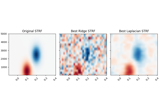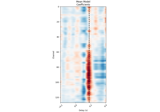mne.decoding.ReceptiveField#
- class mne.decoding.ReceptiveField(tmin, tmax, sfreq, feature_names=None, estimator=None, fit_intercept=None, scoring='r2', patterns=False, n_jobs=None, edge_correction=True)[source]#
Fit a receptive field model.
This allows you to fit an encoding model (stimulus to brain) or a decoding model (brain to stimulus) using time-lagged input features (for example, a spectro- or spatio-temporal receptive field, or STRF) [1][2][3][4].
- Parameters:
- tmin
float The starting lag, in seconds (or samples if
sfreq== 1).- tmax
float The ending lag, in seconds (or samples if
sfreq== 1). Must be >= tmin.- sfreq
float The sampling frequency used to convert times into samples.
- feature_names
array, shape (n_features,) |None Names for input features to the model. If None, feature names will be auto-generated from the shape of input data after running
fit.- estimatorinstance of
sklearn.base.BaseEstimator|float|None The model used in fitting inputs and outputs. This can be any scikit-learn-style model that contains a fit and predict method. If a float is passed, it will be interpreted as the
alphaparameter to be passed to a Ridge regression model. IfNone, then a Ridge regression model with an alpha of 0 will be used.- fit_interceptbool |
None If True (default), the sample mean is removed before fitting. If
estimatoris asklearn.base.BaseEstimator, this must be None or matchestimator.fit_intercept.- scoring[‘r2’, ‘corrcoef’]
Defines how predictions will be scored. Currently must be one of ‘r2’ (coefficient of determination) or ‘corrcoef’ (the correlation coefficient).
- patternsbool
If True, inverse coefficients will be computed upon fitting using the covariance matrix of the inputs, and the cross-covariance of the inputs/outputs, according to [5]. Defaults to False.
- n_jobs
int|str Number of jobs to run in parallel. Can be ‘cuda’ if CuPy is installed properly and
estimator is None.New in v0.18.
- edge_correctionbool
If True (default), correct the autocorrelation coefficients for non-zero delays for the fact that fewer samples are available. Disabling this speeds up performance at the cost of accuracy depending on the relationship between epoch length and model duration. Only used if
estimatoris float or None.New in v0.18.
- tmin
- Attributes:
- coef_array, shape ([n_outputs, ]n_features, n_delays)
The coefficients from the model fit, reshaped for easy visualization. During
mne.decoding.ReceptiveField.fit(), ifyhas one dimension (time), then_outputsdimension here is omitted.- patterns_array, shape ([n_outputs, ]n_features, n_delays)
If fit, the inverted coefficients from the model.
- delays_
array, shape (n_delays,), dtypeint The delays used to fit the model, in indices. To return the delays in seconds, use
self.delays_ / self.sfreq- valid_samples_
slice The rows to keep during model fitting after removing rows with missing values due to time delaying. This can be used to get an output equivalent to using
numpy.convolve()ornumpy.correlate()withmode='valid'.
Methods
fit(X, y)Fit a receptive field model.
Get metadata routing of this object.
get_params([deep])Get parameters for this estimator.
predict(X)Generate predictions with a receptive field.
score(X, y)Score predictions generated with a receptive field.
set_params(**params)Set the parameters of this estimator.
See also
Notes
For a causal system, the encoding model will have significant non-zero values only at positive lags. In other words, lags point backward in time relative to the input, so positive lags correspond to previous input time samples, while negative lags correspond to future input time samples.
References
- fit(X, y)[source]#
Fit a receptive field model.
- Parameters:
- Returns:
- selfinstance
The instance so you can chain operations.
Examples using
fit:
Spectro-temporal receptive field (STRF) estimation on continuous data
Spectro-temporal receptive field (STRF) estimation on continuous data
- get_metadata_routing()[source]#
Get metadata routing of this object.
Please check User Guide on how the routing mechanism works.
- Returns:
- routing
MetadataRequest A
MetadataRequestencapsulating routing information.
- routing
- predict(X)[source]#
Generate predictions with a receptive field.
- Parameters:
- X
array, shape (n_times[, n_epochs], n_channels) The input features for the model.
- X
- Returns:
- y_pred
array, shape (n_times[, n_epochs][, n_outputs]) The output predictions. “Note that valid samples (those unaffected by edge artifacts during the time delaying step) can be obtained using
y_pred[rf.valid_samples_].
- y_pred
Examples using
predict:
Spectro-temporal receptive field (STRF) estimation on continuous data
Spectro-temporal receptive field (STRF) estimation on continuous data
- score(X, y)[source]#
Score predictions generated with a receptive field.
This calls
self.predict, then masks the output of this andy` with ``self.valid_samples_. Finally, it passes this to asklearn.metricsscorer.- Parameters:
- Returns:
Examples using
score:
Spectro-temporal receptive field (STRF) estimation on continuous data
Spectro-temporal receptive field (STRF) estimation on continuous data
Examples using mne.decoding.ReceptiveField#

Spectro-temporal receptive field (STRF) estimation on continuous data
